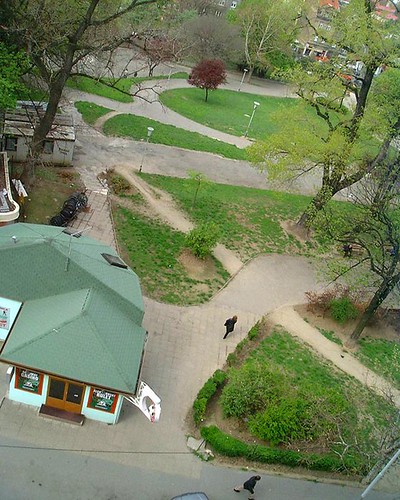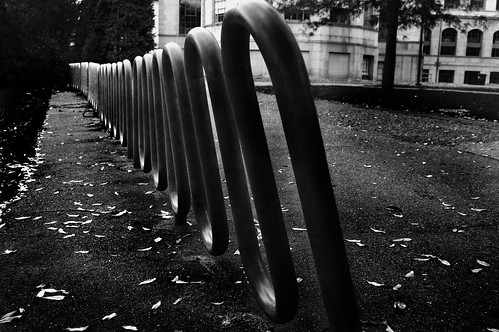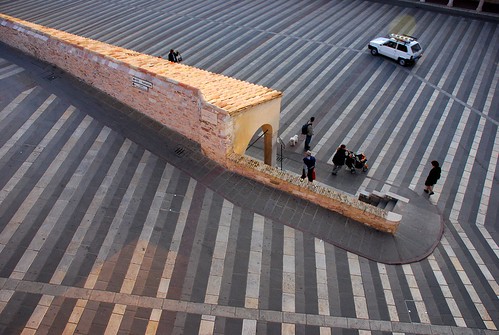
Our CBD streets can look as calm as this central street in London after congestion pricing...via The City Fix.
Just got the good news about congestion pricing for NYC. There will be a press conference at City Hall at 11 AM Tuesday April 1. Bring everyone to celebrate! And if you haven't already, call your State reps to encourage them to support the scheme.
3.31.2008
30-20 for Better Transit
Posted by Shin-pei at 10:25 PM 0 comments
Jane Jacobs, Moynihan Station, and general feelings of apprehension
I've been thinking about the "Jacobsian" philosophy a lot lately, as it seems that more entities use The Death and Life as a way of defending their proposals, i.e. "inspired by Jane Jacobs." Many of these projects embody, at face value, a fundamental hypocrisy (such as new walkable communities in the desert joust utside of Las Vegas proper.) I thought more about it after this panel I attended about Jane Jacobs at the Strand last Thursday night. The panel featured a couple of my favorite writers, Phillip Lopate, Karrie Jacobs, and a fine cartoonist, Ben Katchor, who all presented piece of their work in the book Block by Block which accompanies the Jane Jacobs exhibit at the Municipal Art Society.
Yet as Jacobs is being used to support unsustainable development, it is also used by those who oppose change in our city. It's been troubling to me to hear of projects that are obvious wins for the public to be hamstrung and blocked from execution for a variety of reason, and then also, as the kicker, to be claimed as a project that is against Jane Jacobs. See this post by Karrie Jacobs about Moynihan Station.
Jane Jacobs continues to captivate so many is because her writing relates the many multiple beauties of city living, and at a scale (i.e., small) that was overlooked by planners during her time in New York. There's something about it that captures the imagination for those who care about cities. However, while it may seem that Jane Jacobs would be opposed to many of our proposed changes because we have ushered in so many large-scale projects - some good, some bad, some downright terrible - I think that to immediately assume scale as an indication of public value, or to oppose change for the sake of it, is a mistake. Our city has more than 8 million people. Our infrastructure and our network of shared spaces and streets, are necessarily large. Our population is projected to explode in the short-term, and we need large public works to support us. (For example, Moynihan Station and congestion pricing; both are large-scale efforts). I wholly believe that this is in line with Jane Jacobs; her lament was centered around the divestment of our city, the short-sighted investment of the suburbs and the thoughtlessly-wide brush-stroke of Moses-era planning. This is an era where we are investing in our city. We need good planning that can think big as well as it can delicately fine-tune sidewalk widths. My reading of Jacobs is that she would support large-scale progress, especially when it is change that allows the street ballet to continue. All of this bears saying because there are a lot of New York projects that really are making change for the better right now, and if you can't stop and recognize the good of those projects, then what's the point of fighting at all?
(The panel discussion was filmed and was supposed to be posted somewhere, but I can't seem to find it. If you are dying with curiosity about what was said, check the Strand or Futureofny.org site after a few more days. Or you can just buy the book.)
Posted by Shin-pei at 10:17 AM 0 comments
3.30.2008
Muhheakantuck - Everything Has a Name


Tonight I went to see a CreativeTime exhibit by Matthew Cunningham. I'm fascinated with the process of mapping and how our world, physical and otherwise, becomes defined.
There is another weekend's worth of showings (April 4-5, reservations required), and if you miss it entirely, I highly recommend trying the Water Taxi, especially right after sunset, and after having read up on Russell Shorto's The Island at the Center of the World. It's not the same, but about as close as you can get. (ED: Shorto's book is worth reading, Water Taxi notwithstanding.)

Posted by Shin-pei at 11:26 PM 0 comments
New activity in the Meatpacking District

Very successful traffic calming indeed! If you can believe it, these people are sitting in the middle of a stream of several lanes of traffic. Saturday was not even the warmest of days, but this space still managed to draw people and make them linger. This is the result of work that was started in 2005 with PPS, the Meatpacking Business Improvement District, and the New York City Streets Renaissance. Here's an overview of the initial approachapproach that was then taken up with more community workshops led by RPA, then synthesized into an amenable solution by Sam Schwartz, with parties from all steps participating throughout.
Posted by Shin-pei at 11:07 PM 1 comments
3.19.2008
Desire paths

This one by Phil Gyford
Here's a flickr pool with loads of them.
Thanks Corey!
Posted by Shin-pei at 4:37 PM 0 comments
3.18.2008
Transit Famo

It's not often that an argument for more mass transit to connect Brooklyn Queens and the Bronx is bookended by Randy Watson. You have to check it out for yourself. From F.A.T.
Posted by Shin-pei at 2:38 PM 0 comments
Enlivening a dead sunken plaza

Pablo Valbuena's approach is beautiful. Watch the full video here.
Posted by Shin-pei at 1:01 PM 0 comments
Designing Connected Places


I don't qualify for this summer program about Designing Connected Places in Torino Italy, so I want someone else to go and experience it!
Posted by Shin-pei at 10:31 AM 0 comments
3.15.2008
3.14.2008
NYC Bike Rack Competition

From flickr
Calling all innovators: NYCDOT and Cooper-Hewitt Design Museum just announced a new competition for a bike rack design and indoor bike parking. This isn't just an ideas competition - there is $50,000 for prototyping the winning design (along with $15,000 worth of prize money for the winners.)
Check out the CityRacks competition site and the full NYCDOT release.
I'm thrilled by this news - not only is it the DOT taking initiative with a unique partnership, there's design momentum behind it AND there's money set aside for prototyping so you can actually see your design come to life. This competition should not be missed. No bike racks and secure bike parking are actually the main reasons our office does not ride to work, and the building management (one of the largest in the city) is entirely unsympathetic. (It's SL Green, btw, and don't even get me started about its horrible recycling policy.)
Posted by Shin-pei at 11:49 AM 0 comments
3.12.2008
Good news on the public spaces front

From flickr
"Latin Food Vendors to Stay at Brooklyn Soccer Field"
Here's a food review of one of the vendors.
Posted by Shin-pei at 4:04 PM 0 comments
3.11.2008
World's Best Public Spaces

By flickr contributor gravestmor
There's a Flickr pool of World's Best Public Spaces. What do you think?
(Superlatives abound these days.)
Posted by Shin-pei at 10:57 AM 2 comments
3.05.2008
Suburban slumming?

A thought-provoking Atlantic Monthly article about the potential demise of the traditional American suburbs as the subprime mortgage crisis unfurls.
One thing it reminded me of was the background anxiety I felt growing up in the suburbs. I spent most of my high school years without parents around and always had a sense of anxiety when coming back to our house when my sister and I had been gone for the day. What would stop anyone from breaking in, hiding in the basement and then sneaking out to terrorize us? Maybe I was watching too many horror movies, but I always thought the collective brainwave that thought suburban neighborhoods were safer than cities - when you literally never saw a friendly soul on a suburban street ever - was off.
The article also reminded me of a TV show I caught only once, on one of the many home improvement networks out there. I now can't remember the name of it, but there was a guy with a British-accent who found new homeowners of very poorly constructed housing. Their homes were, perhaps after only a couple of years, really falling apart. Literally stuff like rain dripping from the sills on the inside of the house. The host would then go on a rampage making the houses more solid, whether it was putting insulation in the attic, caulking around window sills, etc, really basic stuff. The best part is how angry and indignant he got about it - and rightly so. This sounds random, but if you read the AM article, you'll know what I'm talking about.
Posted by Shin-pei at 11:23 AM 0 comments
